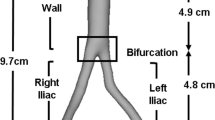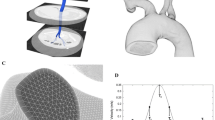Abstract
The velocity field in a patient-specific abdominal aneurysm model including the aorto–iliac bifurcation was measured by 2D PIV. Phase-averaged velocities obtained in 14 planes reveal details of the flow evolution during a cycle. The aneurysm expanding asymmetrically toward the anterior side of the aorta causes the generation of a vortex at its entrance, covering the entire aneurysm bulge progressively before flow peak. The fluid entering the aneurysm impinges on the left side of its distal end, following the axis of the upstream aorta segment, causing an increased flow rate in the left (compared to the right) common iliac artery. High shear stresses appear at the aneurysm inlet and outlet as well as along the posterior wall, varying proportionally to the flow rate. At the same regions, elevated flow disturbances are observed, being intensified at flow peak and during the deceleration phase. Low shear stresses are present in the recirculation region, being two orders of magnitude smaller than the previous ones. At flow peak and during the deceleration phase, a clockwise swirling motion (viewed from the inlet) is present in the aneurysm due to the out of plane curvature of the aorta.
















Similar content being viewed by others
References
Amanuma M, Mohiaddin RH, Hasegawa M, Heshiki A, Longmore DB (1992) Abdominal aorta: characterisation of blood flow and measurement of its regional distribution by the cine magnetic resonance phase-shift velocity mapping. Eur Radiol 2:559–564
Anagnostopoulos J, Mathioulakis DS (2004) Unsteady flow field in a square tube T-junction. Phys Fluids 3900–3910
Asbury CL, Ruberti JW, Bluth EI, Peattie RA (1995) Experimental investigation of steady flow in rigid models of abdominal aortic aneurysms. Ann Biomed Eng 23:29–39
Baek H, Jayaraman MV, Karniadakis GE (2009a) Wall shear stress and pressure distribution on aneurysms and infundibulae in the posterior communicating artery bifurcation. Ann Biomed Eng 37(12):2469–2487
Baek H, Jayaraman MV, Richardson PD, Karniadakis GE (2009b) Flow instability and wall shear stress variation in intracranial aneurysms, interface. J R Soc Interface. doi:10.1098/rsif.2009.0476
Berge SA, Jou LD (2000) Flows in stenotic vessels. Annu Rev Fluid Mech 32:347–382
Bluestein D, Dumont K, Matthieu DB, Ricotta J, Impellizzeri P, Verhegghe B, Verdonck P (2009) Intraluminal thrombus and risk of rupture in patient specific abdominal aortic aneurysm—FSI modeling. Comput Meth Biomech Biomed Eng 12:73–81
Boutsianis E, Guala M, Olgac U, Wildermuth S, Hoyer K, Ventikos Y, Poulikakos D (2009) CFD and PTV steady flow investigation in an anatomically accurate abdominal aortic aneurysm. J Biomech Eng. doi:10.1115/1.3002886
Caro G (2009) Discovery of the role of wall shear in atherosclerosis. Arterioscler Thromb Vasc Biol 29:158–161
Cebral JR, Castro MA, Burgess JE, Pergolizzi RS, Sheridan MJ, Putman CM (2005) Characterization of cerebral aneurysms for assessing risk of rupture by using patient-specific computational hemodynamics models. Am J Neuroradiol 10:2550–2559
Cebral J, Radaelli A, Frangi A, Putman C (2007) Hemodynamics before and after bleb formation in cerebral aneurysms. Proc SPIE. doi:10.1117/12.709240
Dalman R, Tedesco M, Myers J, Taylor C (2006) AAA disease mechanism, stratification, and treatment. Ann NY Acad Sci 1085:92–109
Durst F, Ray S, Unsal B, Bayoumi O (2005) The development lengths of laminar pipe and channel flows. J Fluids Eng ASME 127:1154–1160
Faulkner SL, Fisher RD, Conkle DM, Page DL, Bender HW Jr (1975) Effect of blood flow rate on subendothelial proliferation in venous autografts used as arterial substitutes. Circulation 52(2 Suppl):I163–I172
Fraser KH, Li MX, Lee WT, Easson WJ, Hoskins PR (2009) Fluid-structure interaction in axially symmetric models of abdominal aortic aneurysms. Proc Inst Mech Eng H 223(2):195–209
Georgakarakos E, Ioannou CV, Kamarianakis Y, Papaharilaou Y, Kostas T, Manousaki E, Katsamouris AN (2010) The role of geometric parameters in the prediction of abdominal aortic aneurysm wall stress. Eur J Vasc Endovasc Surg 39(1):42–48
Giordana S, Sherwin SJ, Peiro J, Doorly DJ, Papaharilaou Y, Caro CG (2005) Automated classification of peripheral distal bypass geometries reconstructed from medical data. J Biomech 38:47–62
Humphrey JD, Taylor CA (2008) Intracranial and abdominal aortic aneurysms: similarities, differences, and need for a new class of computational models. Annu Rev Biomed Eng 10:221–246
Jou L, Lee D, Morsi H, Mawad M (2008) Wall shear stress on ruptured and unruptured intracranial aneurysms at the internal carotid artery. Am J Neuroradiol 29:1761–1767
Krijger J, Hillen B, Hoogstraten H (1991) Pulsating entry flow in a plane channel. J Appl Math Phys (ZAMP) 42:139–153
Ku DN, Glagov S, Moore JE, Zarins CK (1989) Flow patterns in the abdominal aorta under simulated postprandial and exercise conditions: an experimental study. J Vasc Surg 9(2):309–316
Lasheras J (2007) The biomechanics of arterial aneurysms. Annu Rev Fluid Mech 39:293–319
Lu Y, Lu X, Zhuang L, Wang W (2002) Breaking symmetry in non-planar bifurcations: distribution of flow and wall shear stress. Biorheology 39:431–436
Malek AM, Alper SL, Izumo S (1999) Hemodynamic shear stress and its role in atherosclerosis. JAMA 282(21):2035–2042
Meng H, Wang Z, Hoi Y, Gao L, Metaxa E, Swartz D, Kolega J (2007) Complex hemodynamics at the apex of an arterial bifurcation induces vascular remodeling resembling cerebral aneurysm initiation. Stroke 38:1924–1931
Mills CJ, Gabe IT, Gault JH, Mason DT, Ross J, Braunwald E, Shillingford JP (1970) Pressure–flow relationships and vascular impedance in man. Cardiovasc Res 4:405–417
Moore J, Ku D (1994) Pulsatile velocity measurements in a model of the human abdominal aorta under resting conditions. J Biomech Eng 116:337–346
Moore J, Xu C, Glagov S, Zarins C, Ku D (1994) Fluid wall shear stress measurements in a model of the human abdominal aorta: oscillatory behavior and relationship to atherosclerosis. Atherosclerosis 110:225–240
Nikolaidis N, Mathioulakis DS (2002) Axial and secondary flow study in a 90 deg bifurcation under pulsating conditions using PIV. J Fluids Eng 122:505–511
Pappu A, Dardik A, Tagare H, Gusberg RJ (2008) Beyond fusiform and saccular: a novel quantitative tortuosity index may help classify aneurysm shape and predict aneurysm rupture potential. Ann Vasc Surg 22(1):88–97
Pedersen E, Sung W, Burlson A, Yoganathan A (1993) Two-dimensional velocity measurements in a pulsatile flow model of the normal abdominal aorta simulating different hemodynamic conditions. J Biomech 26:1237–1247
Perktold K, Rappitsch G (1995) Computer simulation of local blood flow and vessel mechanics in a compliant carotid artery bifurcation model. J Biomech 28(7):845–856
Rindt CCM, Van Steenhoven AA, Janssen JD, Vossers G (1991) Unsteady entrance flow in a 90° curved tube. J Fluid Mech 226:445–474
Rodriguez JF, Martufi G, Doblare M, Finol EA (2009) The effect of material model formulation in the stress analysis of abdominal aortic aneurysms. Ann Biomed Eng 37(11):2218–2221
Salsac AV (2005) Changes in the hemodynamic stresses occurring during the enlargement of abdominal aortic aneurysms. PhD thesis, University of California, San Diego
Sforza DM, Putman CM, Cebral JR (2009) Hemodynamics of cerebral aneurysms. Annu Rev Biomed Eng 41:91–107
Shipkowitz T, Rodgers V, Frazin L, Chandran K (2000) Numerical study on the effect of secondary flow in the human aorta on local shear stresses in abdominal aortic branches. J Biomech 33:717–728
Speelman L (2009) Biomechanical analysis for abdominal aortic aneurysm risk stratification. PhD thesis, Universiteit Maastricht, Eindhoven
Speelman L, Schurink GW, Bosboom EM, Buth J, Breewer M, Van de Vosse FN, Jacobs MH (2009) The mechanical role of thrombus on the growth rate of an abdominal aortic aneurysm. J Vasc Surg 51(1):19–26
Stamatopoulos C, Papaharilaou Y, Mathioulakis DS, Katsamouris A (2010) Steady and unsteady flow within an axisymmetric tube dilatation. Exp Therm Fluid Sci 34:915–927. doi:10.1016/j.expthermflusci.2010.02.008
Taylor CA, Hughes TJR, Zarins CK (1998) Finite element modeling of three-dimensional pulsatile flow in the abdominal aorta: relevance to atherosclerosis. Ann Biomed Eng 26:975–987
Taylor CA, Cheng CP, Espinosa LA, Tang BT, Parker D, Herfkens RJ (2002) In vivo quantification of blood flow and wall shear stress in the human abdominal aorta during lower limb exercise. Ann Biomed Eng 30:402–408
Tuttle E (1990) Laminar flow in twisted pipes. J Fluid Mech 219:545–570
Vetel J, Garon A, Pelletier D (2009) Lagrangian coherent structures in the human carotid artery bifurcation. Exp Fluids 46(6):1067–1079
Wurzinger LJ, Blasberg P, Schmid-Schonbein H (1985) Towards a concept of thrombosis in accelerated flow: rheology, fluid dynamics, and biochemistry. Biorheology 22:437–449
Xiaoyi H, Ku D (1994) Unsteady entrance flow development in a straight tube. J Bioeng 116:355–360
Acknowledgments
This paper is part of the 03ED244 research project, implemented within the framework of the ‘Reinforcement Programme of Human Research Manpower’ (PENED) and co-financed by National and Community Funds (20% from the Greek Ministry of Development—General Secretariat of Research and Technology and 80% from EU—European Social Fund).
Author information
Authors and Affiliations
Corresponding author
Rights and permissions
About this article
Cite this article
Stamatopoulos, C., Mathioulakis, D.S., Papaharilaou, Y. et al. Experimental unsteady flow study in a patient-specific abdominal aortic aneurysm model. Exp Fluids 50, 1695–1709 (2011). https://doi.org/10.1007/s00348-010-1034-6
Received:
Revised:
Accepted:
Published:
Issue Date:
DOI: https://doi.org/10.1007/s00348-010-1034-6




